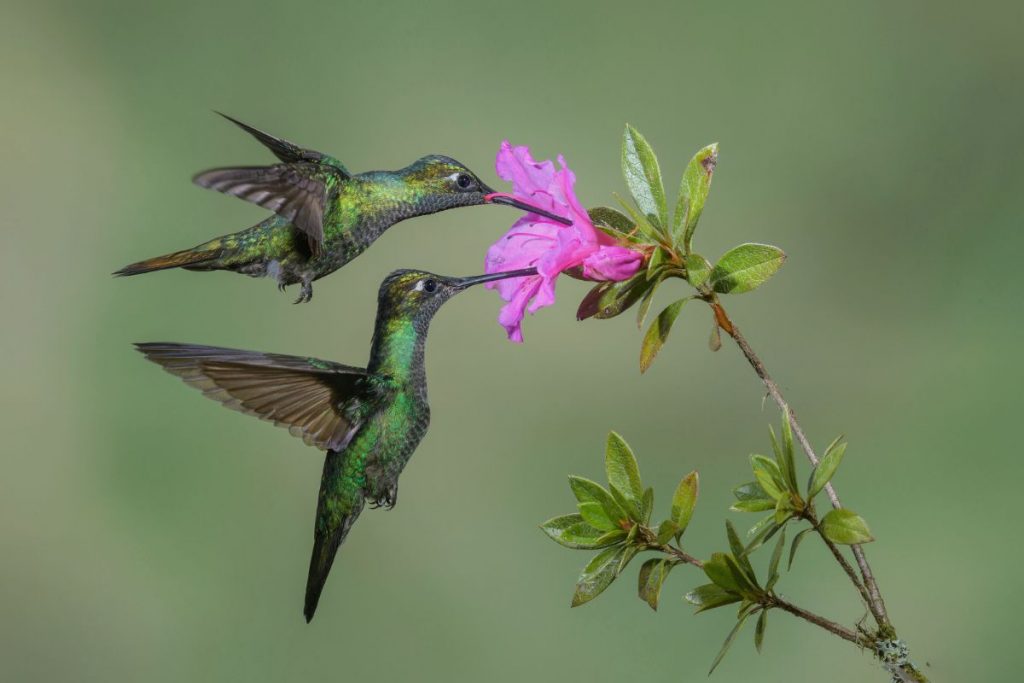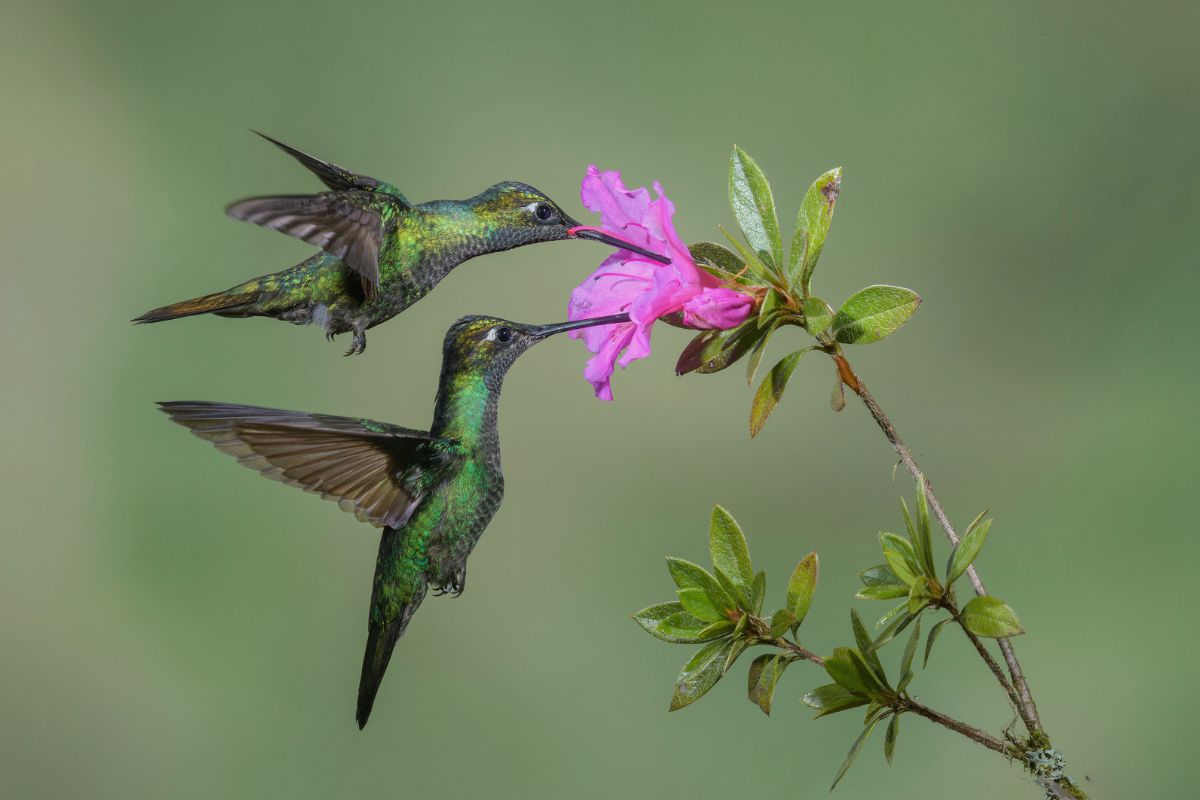Yes, there are indeed hummingbirds in Michigan! The Ruby-throated Hummingbird is the only species of hummingbird that breeds in Michigan, but it is quite a sight to behold. With their shimmering green plumage and the male’s bright red throat, these tiny birds add a touch of magic to the Great Lakes State.
In this post, we’ll explore the world of Michigan’s hummingbirds, from their arrival in the spring to the best ways to attract and support them in your backyard.
- Migration and Arrival: When to Expect Hummingbirds in Michigan
- Feeding and Nesting: The Intricate Lives of Michigan's Hummingbirds
- Attracting Hummingbirds to Your Garden: Tips for Creating a Hummingbird Haven
- Heading South: The End of the Season
- The Importance of Conservation: Protecting Michigan's Hummingbirds
- Fun Facts About Ruby-throated Hummingbirds
- A Final Word: Celebrating Michigan's Winged Jewels
- Image Gallery – Are There Hummingbirds In Michigan?
Migration and Arrival: When to Expect Hummingbirds in Michigan
Ruby-throated Hummingbirds spend the winter in Central America and then migrate to North America for the breeding season, which typically starts in late April or early May. In Michigan, the first sightings of these birds usually occur in the southern part of the state, and by mid-May, they can be found throughout Michigan.

Feeding and Nesting: The Intricate Lives of Michigan’s Hummingbirds
During the breeding season, Michigan’s Ruby-throated Hummingbirds are busy feeding on nectar, insects, and spiders. They need to consume large amounts of nectar to fuel their high metabolism, which allows them to maintain their rapid wing beats and incredible agility.
In addition to nectar, they also consume small insects and spiders, which provide essential proteins and nutrients.
Ruby-throated Hummingbirds build tiny, cup-shaped nests using plant materials and spider silk. The female will lay two tiny, white eggs, and incubation lasts for about two weeks.
Once the young hatch, the female is responsible for feeding them a mixture of nectar and insects. The chicks fledge in about three weeks, and the female continues to feed them for several days after they leave the nest.
Attracting Hummingbirds to Your Garden: Tips for Creating a Hummingbird Haven
If you’re a Michigan resident keen on welcoming hummingbirds to your garden, here are some tips to create the perfect environment for these enchanting birds:
- Plant a hummingbird-friendly garden: Hummingbirds are attracted to bright, tubular flowers that produce ample nectar. Native plants like red columbine, trumpet honeysuckle, and bee balm are great options. Additionally, incorporating a variety of flowering plants that bloom at different times will provide a continuous food source throughout the season.
- Provide a water source: Hummingbirds need fresh water to drink and bathe. A shallow birdbath or a small fountain with a gentle spray can be a great addition to your garden.
- Offer supplemental food: You can also provide a hummingbird feeder filled with a nectar solution to supplement their natural food sources. A simple homemade nectar solution can be made by mixing one part white granulated sugar with four parts water. Avoid using red food colouring or honey, as these can be harmful to the birds.
- Minimize pesticide use: Insecticides can reduce the availability of insects, which are an important food source for hummingbirds. Try using more natural methods to control pests in your garden.
- Provide perching spots: Hummingbirds like to rest and survey their territory from perches. Providing small branches or installing a thin hummingbird swing can give them a place to rest and preen.
Heading South: The End of the Season
By late August and September, Michigan’s Ruby-throated Hummingbirds will start their journey back to Central America for the winter. As daylight hours decrease and temperatures begin to drop, the birds will sense that it’s time to migrate. It’s essential to keep your feeders and flowering plants available until the last hummingbirds have departed to ensure they have enough fuel for their long journey south.

The Importance of Conservation: Protecting Michigan’s Hummingbirds
While Ruby-throated Hummingbirds are not currently considered a threatened species, they still face challenges that can impact their population. Habitat loss, pesticide exposure, and climate change can all have detrimental effects on these delicate creatures. By creating a hummingbird-friendly environment and promoting conservation efforts, we can help ensure that these enchanting birds continue to grace Michigan’s landscapes for generations to come.
Fun Facts About Ruby-throated Hummingbirds
Before we conclude our exploration of hummingbirds in Michigan, let’s take a moment to appreciate some fascinating facts about these incredible creatures:
- The Ruby-throated Hummingbird can beat its wings up to 53 times per second, allowing it to hover in mid-air while feeding on nectar.
- These hummingbirds are capable of flying long distances during migration. They can cover up to 500 miles in a single flight while crossing the Gulf of Mexico.
- Hummingbirds are known for their incredible memories. They can remember the locations of various flowers in their territory and the last time they visited each one to feed.
- Despite their small size, hummingbirds are fiercely territorial and will aggressively defend their feeding and nesting areas from other hummingbirds and even larger birds.
A Final Word: Celebrating Michigan’s Winged Jewels
Michigan’s Ruby-throated Hummingbirds are truly a sight to behold. Their arrival each spring brings a touch of magic to the state’s gardens, woodlands, and meadows.
By creating hummingbird-friendly habitats, we can support these beautiful creatures and enjoy their enchanting presence in our own backyards.
As you watch them flit from flower to flower, take a moment to appreciate their delicate beauty and the role they play in our ecosystem.
The presence of hummingbirds in Michigan is a reminder that nature’s wonders are never far away, and with a little effort, we can help protect and preserve these precious gems for future generations.
Image Gallery – Are There Hummingbirds In Michigan?



Related Posts to Read:
- Best Hummingbird Feeders.
- Are There Hummingbirds In Alabama?
- Are There Hummingbirds in Europe?
- Are There Hummingbirds in Australia?
- Are There Hummingbirds In The Caribbean?
- Are There Hummingbirds In Canada?
- Are There Hummingbirds In Jamaica?
- Are There Hummingbirds In Florida?
- Are There Hummingbirds In Massachusetts?
- Are There Hummingbirds In New Zealand?
References:
- About Hummingbird (Wikipedia).
- About Michigan (Wikipedia)
- Greenewalt, C. H. (1960). Hummingbirds. New York: Doubleday. Google Scholar.
